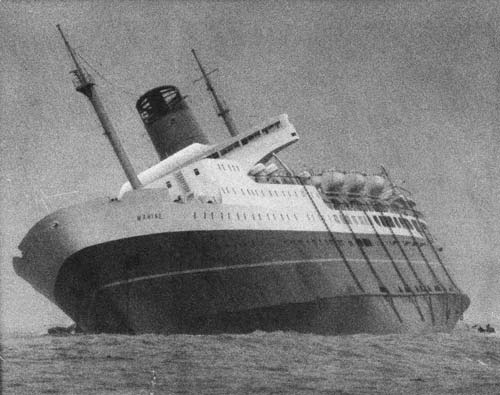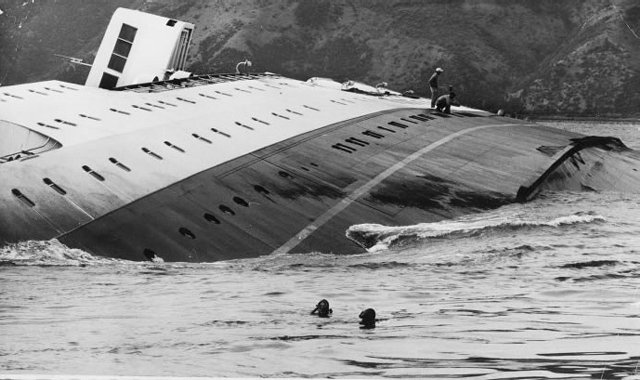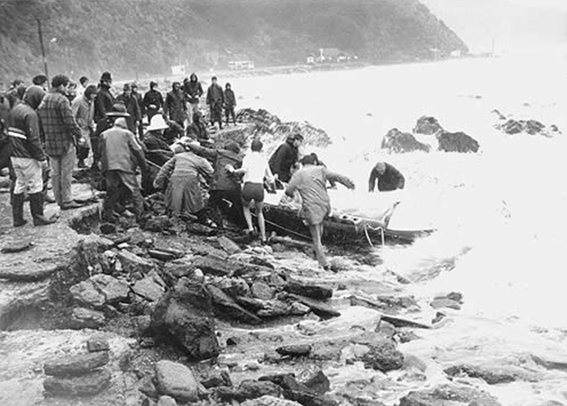The sinking of the Wahine 10 April 1968Though there have been worse shipping disasters in New Zealand with far greater loss of life, the sinking of the Wahine in 1968 is by far the most well known.
The tragedy can be attributed to one major cause - the weather. The storm which exploded upon Wellington was one of the worst ever recorded in New Zealand. Its ferocity was due to it being a combination of two storms which by chance happened to merge directly over Wellington.
The first storm began several days before as a minor tropical cyclone to the far north of New Zealand. It was initially expected to pass over the Chatham Islands, but on the night of 9-10 April (the limitations of technology at the time meant it could not be tracked overnight), it dramatically changed course and headed south to Wellington. At the same time a deep depression was heading up the South Island - and the two storms clashed together at almost exactly the same time as the overnight Lyttleton - Wellington ferry T.E.V Wahine approached the harbour entrance.
Massive waves and hurricane force winds led to the ship being forced on to Barrett's Reef. This resulted in the loss of her starboard propeller and the failure of her port engine, leaving the ship without any propulsive power. With capsize inevitable, the order to abandon ship was given early that afternoon. Of the 734 passengers and crew on board, 51 people lost their lives.
On shore, the storm also resulted in massive damage, flooding and injuries as people were hit by flying debris. The storm also marked the coming-of-age for television news broadcasting in New Zealand as camera crews rushed to report on events as they unfolded. The resulting footage was screened around the world as the world's media spotlight turned its attention to Wellington. Television coverage of the disaster later went on to win an international World News film award.
The disaster has also been well documented by historians and journalists. Below are a number of resources which can be found in the Central Library to help you research the sinking of the Wahine in greater detail. Some of the books may also be available in branch libraries - each book title links through to the libraries' online catalogue so you can check location and availability.
Wanganui River Drownings Sunday 10 April 1910Drowning in 19th century New Zealand was so common it became known as “The New Zealand Disease”.
What today are known as quite “tame” rivers and streams held great danger for settlers who relied on fording by foot or on horseback or on a ferry or punt crossing. Being an island nation the weather was very changeable and streams you could jump over in the morning became major torrents a few hours later. Until the railway opened up much of New Zealand travel was by coastal shipping and dangerous river bars claimed many lives.
This story of the LUDLAM and ANDERSON families is a memorial to all those who died from the New Zealand disease.
On Sunday the 10 April 1910, the LUDLAM and ANDERSON families who were near neighbours in Abbott, Wanganui ( Abbott was a tiny settlement on the Wanganui River where the fishing club is now - on the road that runs parallel to Heads Rd near the Castlecliff end. There were only ever about six houses there - by the 1930's there was only one house left. ) decided to cross the river for a family picnic at South Beach. They used a 16-foot boat to carry the parties across in two separate trips. The first party made it safely across but the second ran into difficulties with an increasing wind and outgoing tide which created heavy waves. The boat tried to turn back when a huge wave swamped it and all the occupants were thrown in to the river with no survivors.


